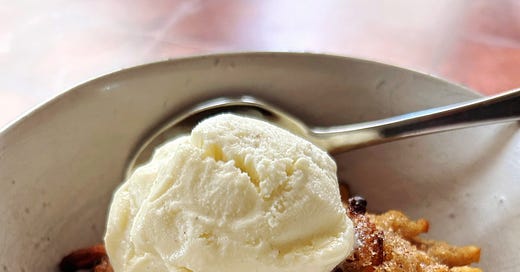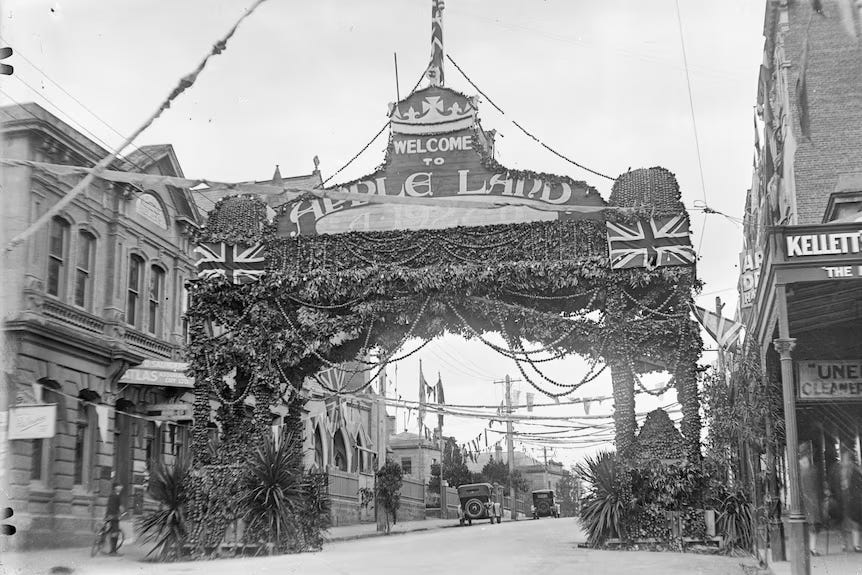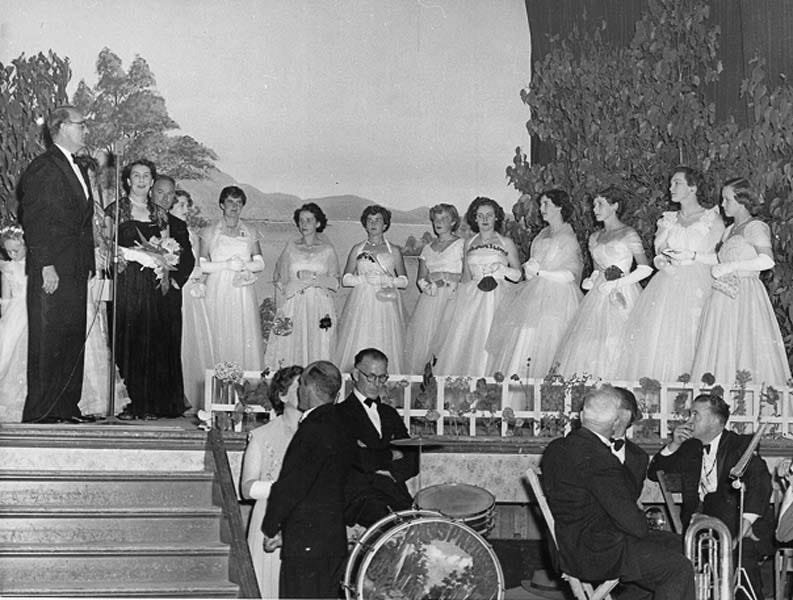Driving to Hobart there is a large swath of what used to be pasture that has recently been turned over. There is a tractor running back and forth over the land, breaking up the soil and exposing it to the elements. I can’t help thinking it will be planted with apple trees shortly. Since our arrival in Tasmania four years ago, I’ve noticed plenty of new plantings. Young apple trees are set in rows, and then after they have been established for a little while, the timber supports are added. A couple of seasons later, the foliage has thickened, and there is even the occasional apple.
Apples and Tasmania have gone hand in hand since the state was first colonised by the Europeans. So much so that it used to be known as the Apple Isle. In 1927, the Duke and Duchess of York were greeted in Hobart by a large street arch constructed from apples and proudly proclaiming, “Welcome to Apple Land”.
The 1950s and 1960s were the height of the apple industry, and its impact was not just commercial and financial, but it also influenced the social aspects of life in Tasmania and, in particular, the Huon Valley. In 1952, the first Apple Festival was held in Cygnet, just across the river from where we live. At the time, about 2500 people lived in Cygnet, and about 1500 of them were involved in putting the festival together and ensuring that it ran smoothly. Just a few years after it started, the festival attracted large numbers, with an estimated 20,000 people attending over the two days. The local police supplied 30 officers to control the traffic and marshall them into the six-hectare parking site.
You might have thought that a festival of this size would be held during a quieter time of the year for the apple industry, but it was held each March, just as the harvest was getting particularly busy. For the locals, the apple industry wasn’t just picking the fruit, but rather, it supported a host of other businesses. Local timber mills prepared the timber that was made into the apple crates, which were made by hand, along with the wood wool that they were packed with. The Port Cygnet Cannery was the largest employer of women in the area, where the main product was apple pie filling. During the festival this workforce would be diverted to its smooth running.
There were competitions for constructing the most apple crates in the shortest amount of time and for wrapping and packing apples the fastest. The local children would sing in a choir, there were floats, tap dancing displays and marching girls. The local women would prepare a huge amount of food served from the canteen to feed festival goers. In 1956, the big draw card was the world’s largest apple pie, a one-tonne slab made by Tasmania’s National Pies company. There were 36 slabs of pie each made with 635 kg of apples and pieced together on site on a huge trailer and closely guarded overnight. The apple pie was cut by Ruth Hammond, newly crowned Apple Queen, with a huge knife that was almost two metres long. A hole had been cut into the trailer, so it looked as though she was cutting through a deep pie rather than the few centimetres that pie really was. The world record pie was cut into pieces, put into cardboard containers, topped with cream and distributed to the festival attendees.

The crowning of the Apple Queen was the highlight of the festival. A visiting celebrity or VIP would name and crown the Apple Queen, placing the crown on her head, draping her in a red robe and handing her the mace. In 1954, Prime Minister Sir Robert Menzies and his wife, Dame Pattie Menzies, crowned the Queen. In 1957, olympian Betty Cuthbert ran a lap of the oval before crowning the Apple Queen. And in 1958, Australian movie star Chips Rafferty rode in a horse-drawn cart around the oval before his wife was given the honour of crowning the Apple Queen.
Women aged between 18 and 28 were able to enter the Apple Queen competition, with the prerequisite being that they had to have some connection to the apple industry. Between eight and 15 potential ‘Queens‘ were interviewed by a panel of judges the day before the festival. This was followed by a lunch where the contestant’s ‘intelligence, confidence and poise’ was assessed. There was a ball on the Saturday night before the announcement and crowning. The role of the Apple Queen was to be an ambassador for the apple industry, and part of the prize was a trip, a sort of working holiday, to promote the Huon Valley apple industry. There were donated gifts of clothing, shoes, hats, bags and china for the winner and a year of events such as visiting interstate fruit markets and national radio interviews.
The timing of the festival, during the apple harvest was both the reason for its success and also its downfall. The energy of the harvest and having fruit available for the various competitions was important, but after a few years, there was resentment that the harvest was brought to a standstill around the time of the festival, with comments about not enough fruit being picked and packed. Twelve years after the first apple festival, the last one was held, a somewhat pared-down event, in 1964. The Apple Queen’s prize, a couple of days in the north of Tasmania, a far cry from the heady days of interstate travel and a year of apple promotion.
It’s an interesting piece of local history. Many of the apple trees were pulled from the ground in the 1970s when the UK joined the Common Market, and as a result, Tasmania lost its main export market. Much of the infrastructure - ports, canneries, apple sheds - associated with the apple industry fell into disrepair. And while apples are still very much a part of this area, their importance economically and socially is not what it was in the heyday of the 1950s and 1960s.
For many of today’s orchardists, finding a point of difference is important. Many grow apple varieties suitable for cider making, or cultivate varieties that are no longer commonly available, those unsuitable for the mass market due to poor keeping times or lack of transportability. It does mean that for locals, the roadside stalls and markets are a wonderful source of lesser-known apples, and I try my best each season to work my way through as many as I can.
Apples are a cold-weather staple at home, and I use them frequently, experimenting with different ways to use them, both in sweet and savoury dishes. I developed these oven-baked apple fritters after having apple fritters for breakfast at a no longer there Hobart restaurant. They were deep-fried, something I can never be bothered to do at home, so I spent some time working on an oven-baked version. They are not quite as crispy as the fried variety and are a little more cakey. I’m more inclined to have them for dessert rather than breakfast, but they are quite moreish. I like to cut the apple into matchsticks rather than grating them so that the apple is more prominent. The most recent batch I made with Braeburn apples; they are good tart apples that keep their shape when they are cooked. Golden Delicious is also lovely, as are Granny Smiths or Pink Ladies.
Oven-Baked Apple Fritters
150 g plain flour
55 g sugar
1 teaspoon baking powder
½ teaspoon salt
½ teaspoon ground cinnamon
½ teaspoon ground nutmeg
Pinch ground cloves
300 g apple, peeled, cored and chopped into matchsticks
80 ml milk
100 g butter, melted
1 teaspoon vanilla essence
50 g sugar, extra
½ teaspoon ground cinnamon extra
Preheat the oven to 200°C. Line a large baking tray with baking paper.
Put the dry ingredients into a large bowl and use a balloon whisk to mix everything together and to remove any lumps. Add the apple matchsticks and toss them gently so that they are covered with flour.
Pour in the milk, melted butter and vanilla essence and stir carefully. Try not to break up the apples too much.
Dollop 8 large spoonsful of the mixture onto the baking tray, leaving a little space between each one. Bake in the oven for 10-15 minutes until they are golden and slightly crunchy. They will flatten out a little.
While the fritters are baking, make cinnamon sugar by mixing together the extra sugar and cinnamon. Remove the fritters from the oven and toss them straight away in the cinnamon sugar. Serve with ice cream. The fritters are best eaten straight away.
Next week: the garlic is in the ground + a garlicky pastie
Each week, I share the latest instalment of the book I am writing here on Substack, Home Baked: a Year of Seasonal Baking. A subscription will ensure you don’t miss any of the stories and recipes. You might also want to consider a paid subscription which will give you access to previous recipes, as well as printer-friendly recipe cards, bonus material, access to Q&A and a quarterly compilation of the recipes. There is also an additional newsletter on Friday, which is a mixed bag and touches on all manner of food topics. I’d love for you to be a part of it.
Paid subscribers will find the printer-friendly recipe card by clicking on the button, along with a visit to a local roadside stall and an apple cider caramel recipe which elevates the fritters to the next level.









That was a fascinating read Julia and I agree with Libby that it's a shame a more scaled down version doesn't still occur. We used to have a pumpkin festival near my town. It was very popular but soon became too big, too many visitors made it unmanageable, then COVID happened. Maybe one day we can see this festival resurrected as well. Those apple fritters sound amazing!
Thank you Julia for that interesting insight into apples in the Huon Valley. A shame a more scaled down version of the festival doesn't still occur.
I buy a bag of apples each Saturday from the Powerhouse Markets at New Farm from a man who comes from Stanthorpe (very rarely from a fruit shop or supermarket) and he is starting to have some new varieties (don't ask what they are - I will pay more attention from now on).
I can also remember each year or maybe even more frequently, my mum would see an advertisement in the Courier Mail for apples and she would order a few boxes (not the shallow boxes you see today) and we would go to the train station and pick them up. No idea where they came from.
Looking forward to trying the fritters.